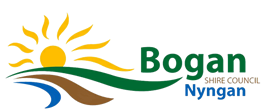The Bogan River
The Bogan River was discovered by Charles Sturt in 1829 and is a minor river in the central western region of New South Wales, Australia. The Bogan starts near Forbes and flows generally north-north-west past Nyngan. Unlike the other main rivers of inland New South Wales, the Bogan does not rise in the well-watered highland areas, so its flow is low and erratic and not much use for irrigation. The Bogan is a tributary of the Darling River. Major Sir Thomas Mitchell reached it in 1835.
Macquarie Marshes
The Macquarie Marshes are an extensive wetland system covering an area of 220,000 hectares in north-west New South Wales, representing one of the largest semi-permanent wetlands in south-eastern Australia.
Commencing in the south at Marebone Weir, which is situated 50kms north of Warren, they extend to the north a further 100kms until all the channels unite to form one near Carinda.
The Northern Marshes provide a scenic landscape of Common Reed (Phragmites Australia's) and River Red Gum (Eucalyptus camaldulenis).The Macquarie Marshes are a well known habitat of many waterbirds. Over 60 species have been sighted here with a reported 42 of the species using the ideal conditions for a breeding place. Ibis, Egrets, Cormorants, Spoonbills and Herons are but a few of the breeding species found at the Macquarie Marshes.
There are also many different varieties of aquatic plants growing freely in this wonderful natural wetland.
The Fauna also presents a rich variety of animals, including several of the mammal species.
Museum
 The Museum is located in the Railway Square and is open Monday to Friday 9am - 4pm. On display are:
The Museum is located in the Railway Square and is open Monday to Friday 9am - 4pm. On display are:
- Boards depicting our history from 1835 when Major Mitchell first ventured down the Bogan River to find many waterholes
- Photographs and history of the Nyngan area
- Video and Photographs of the Nyngan 1990 Flood
- Audio room where older Nyngan residents' stories can be heard
- Display of a 1800's kitchen from Gilgione Station
- A railway display showing the important role the railway played in the history of Nyngan. On display is the railway switchboard, several pieces of luggage, and railway lanterns
- The switchboard from the local telephone exchange. One of five that made up the Switchboard Information Service of the Post Office from 1854 to 1975
- Microfilm reader - with micro film of the Nyngan Newspapers from 1898 to 1996
- Scale model of the Girilambone Copper Company along with many samples of Ore
- The new Remembrance Room
Helicopter
 Iroquois 1022 was donated to the town of Nyngan by the Federal Government to commemorate the evacuation of residents during the tragic 1990 Flood. Helicopters were used to airlift stricken residents out of the town and few would dispute the Iroquois' appropriateness as a symbol of courage. Delivered from the United States in 1962, 1022 played a vital role in the Vietnam War transporting Australian troops and equipment.
Iroquois 1022 was donated to the town of Nyngan by the Federal Government to commemorate the evacuation of residents during the tragic 1990 Flood. Helicopters were used to airlift stricken residents out of the town and few would dispute the Iroquois' appropriateness as a symbol of courage. Delivered from the United States in 1962, 1022 played a vital role in the Vietnam War transporting Australian troops and equipment.  In May 2011 Iroquois 1022 was transported by volunteers to Caloundra in Queensland where the helicopter was fully restored and placed on display at the Caloundra RSL. A restored replacement Iroquois A2-022 was delivered to Nyngan and is now mounted on a pole in Vanges Park, Pangee Street
In May 2011 Iroquois 1022 was transported by volunteers to Caloundra in Queensland where the helicopter was fully restored and placed on display at the Caloundra RSL. A restored replacement Iroquois A2-022 was delivered to Nyngan and is now mounted on a pole in Vanges Park, Pangee Street
Mid State Shearing Shed
 The Mid-State Shearing Shed was built in a disused railway goods shed by a group of retired shearers and the people of Nyngan. Their wish was to inform the public of the important contribution that the shearing industry is continuing to make to Nyngan and New South Wales.
The Mid-State Shearing Shed was built in a disused railway goods shed by a group of retired shearers and the people of Nyngan. Their wish was to inform the public of the important contribution that the shearing industry is continuing to make to Nyngan and New South Wales.
The organisers also wished for the Mid-State Shearing Shed to display the talents of the local artists. These can be seen on the large murals that cover many of the walls.
The Mid-State Shearing Shed is situated on the Mitchell Highway adjacent to a parking bay and Heritage Park.
Open from 9:00am - 12:00pm Monday to Friday, or by appointment: Phone: Frank Walsh 02 6832 1381.
The Big Bogan



